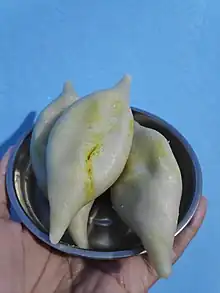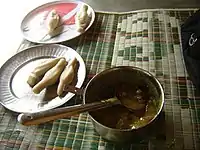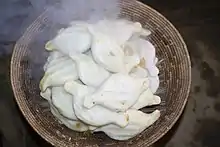
Bagiya

Bagiya

Bagiya
Bagiya (also called Pithha[1]) is a delicacy of the Maithil,[2] Tharu and Dhimal communities of India and Nepal. It is a steamed dumpling that consists of an external covering of rice flour[3] and an inner content of sweet substances such like chaku, vegetables and other fried items. The delicacy plays a very important role in Tharu society, and is a key part of the festival of Diwali (also known as Deepawali or Tihar) on the day of Laxmi Puja.[4][5]
See also
References
- ↑ "मिथिला के खान-पान की संस्कृति की पहचान बगिया". m.jagran.com.
- ↑ "सर्दी में बनने वाले खास स्नैक्स में से एक है यह गुड़ की बगिया". www.pakwangali.in. Retrieved 18 September 2018.
- ↑ "Making Bagiya". Boss Nepal. Retrieved 2018-09-15.
- ↑ "Food and The Nepali". ECS NEPAL. Retrieved 2018-09-15.
- ↑ "Tharu Cuisines and Delicacies (in Pictures) - The Nepali Food Blog | theGundruk.com". The Nepali Food Blog | theGundruk.com. 2016-01-16. Retrieved 2018-09-15.

Bagiya prepared in Dhamma
External links
This article is issued from Wikipedia. The text is licensed under Creative Commons - Attribution - Sharealike. Additional terms may apply for the media files.